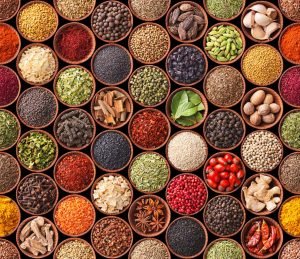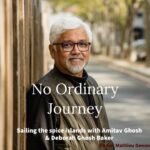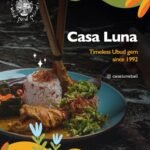On the table before me lies my favourite Balinese meal: nasi campur, a serve of freshly
steamed rice topped with small helpings of delicious things. There is braised tempeh,
gently spiced smoked sardines, wok-fried water spinach with a scattering of sliced chillies,
amber-tinged chicken, warm sprouts and green amaranth tossed in peanut sauce, plus
fried sambal – which I simply can’t live without. Just a spoonful of each alongside the rice
is enough to satisfy the stomach and enliven the tastebuds.
Nasi campur is in fact nothing out of the ordinary, but simply the nourishing daily fare
that is prepared in every home, food stall and market in every Balinese village. The
selection of toppings is determined by the bountiful range of seasonal produce available.
Since I moved to Bali I have eaten nasi campur nearly every day and I will never tire of it.
It pretty well sums up Indonesia: small islands of food brought together by steamed rice.
My first visit to Bali was in 1974 as a Melbourne secondary-school student. It was a
trip that made an impact from which I’ve never recovered. I felt like Alice stepping into
a surreal wonderland of startling beauty and wild energy. I tasted food that defied
description, watched dance movements that resembled the fl utter of gilded butterflies,
and saw processions that took my breath away.
I returned to Bali ten years later in 1984, and on the second day of my holiday I met Ketut,
my husband-to-be. I was staying with a friend at a hotel in
capital in Bali’s highlands. We were relaxing after dinner, soaking in the balmy ambience of
the tropics. Ketut came to join us with a friend and the rest, as they say, is history.
In 1985 I moved in with Ketut to his sister Karsi’s home in Ubud, and we lived there
for two years. Called Nani House, it lay south of a soccer fi eld before a sea of green rice
paddies. In those days Ubud was still a sleepy village and had a special breed of home-
grown charm. Monkey Forest Road was a narrow street lined with purple orchid trees –
for me, one of the prettiest trees on the planet – sadly gone now. There were just a
few popular eateries in town and the main accommodation for visitors apart from the
odd hotel was homestays offering an up-close and personal experience with a local
family. It was all quite different to today, as Ubud now draws throngs of visitors and has
sprouted a plethora of hotels and a world-famous range of restaurants.
I remember spending the late afternoons sitting on the cement steps of Toko Tino’s,
the general store on Jalan Raya, watching a slow-motion world drift by. It was like being
in an open-air cinema. You could sip a fi zzy soda as motorbikes, ducks, school children
and bakso sellers passed. I especially loved watching one crazy old farmer with his cow on
his way home. He would yell at the traffi c or run up behind tourists and scare the daylights
out of them. Invariably, by the time I had finished my drink, there was always a small
group of locals gathered around me asking all sorts of extremely personal questions.
I felt myself becoming fuelled by a voracious thirst for culinary knowledge. I spent my
days hovering around Karsi’s kitchen and others’, and at restaurants and family
ceremonies, and eventually started to think of my experiences as an informal training.
My classroom was Bali and my subject: the elegance of rice and the sensuous, aromatic,
edible pleasures that fl ourish in the tropics. My teachers – the mothers (and a few
fathers) of Ubud – were gracious masters of nurturing and necessity and rustic cooks
of the most humble kind. They provided me with cooking skills that went far beyond
any institutionalised learning, and fundamental lessons of goodwill, sharing and
Asian wellbeing that I’ve taken into my daily life.
In 1987, Ketut and I opened a restaurant called Lilies on Monkey Forest Road. It was my
first taste of running restaurants, or any business for that matter. Soon it was thriving
and hospitality started to feel like a calling.
We were married in my local Melbourne church in 1989, and then the following year,
in Bali. More businesses followed. Our home blossomed into the Honeymoon Guesthouse
which led to the Honeymoon Bakery, then to our restaurants Casa Luna and Indus,
a cooking school, an emporium with our own range of homewares, textiles and artefacts,
and a bar.
While the businesses grew, so did our family. We have four children – Dewi, Krishna,
Laksmi and Arjuna – and they never cease to fascinate me with their own unique blend of
two cultures.
This book is the result o more than twenty-fi ve years of eating and cooking in Indonesia,
from my home in Bali to trips to Java and Sulawesi. In different parts of Indonesia I have
tasted exemplary food, in glamorous restaurants and at rustic stalls and markets, and
have observed authentic regional specialities being made. Some of the best meals I’ve
eaten have been the simplest. But it’s more than just the ingredients involved – it’s about
cooking with heart and a certain breed of humility and generosity to be ingested between
the layers of flavour.
One common thread that unites Indonesian food is the spices – some native to ‘the Spice
Islands’ and some that arrived from afar with trading on the high seas. From galangal,
ginger, pepper, coriander seeds, cloves and nutmeg to the brave statement of chilli, these
aromatic treasures – the currency of old empires – breathe life into every dish. Two other
ingredients that cannot be separated from Indonesian cuisine are coconut, in its many
guises, and palm sugar.
On my culinary journey I have met enigmatic characters who have shared anecdotes,
recipes and glorious meals with me. Many years ago on a visit to Lombok, the
neighbouring island to the east of Bali, I was invited to our driver’s home in Mataram
to share some local specialities. He knew I was fascinated by Indonesian food and he
especially wanted us to meet his family. ‘My mother is a wonderful cook,’ he said. ‘Come
to our house and she will make some special Lombok dishes for you.’
Adorned in a Muslim scarf, his mother sat on the paved fl oor of the family courtyard
chopping and grinding spices. After that she roasted and fried various dishes in her simple
kitchen. We were served sweet ginger tea and rice cakes and instructed to sit on the few
chairs they owned so we could observe this rustic cooking class. Lombok is famous for its
water spinach, tofu, and one of my all-time favourites – salted eggs. It is also known for its
ayam taliwang – spicy marinated chicken that is butterfl ied, then threaded onto bamboo
skewers and chargilled over coconut coals.
I made copious notes as the driver’s mother cooked her own version of ayam taliwang,
the smoky scent of charred chicken fl oating around us. To follow this was a lime-scented
satay of pounded beef, wok-fried water spinach, a bright red tomato sambal, bean
sprout salad and salted eggs. We sat with the driver and enjoyed the superb feast –
spicier than Balinese food and with an extra kick of shrimp paste and an aroma of fresh
coconut oil. His mother was too shy to join us and remained in the shadows, observing
our pleasure in her culinary skills. At the end I felt that the family’s kindness had been
overwhelming and pleaded with the driver to allow me to offer some money for such
generosity. To no avail: ‘It is my honour to entertain you,’ he said.
On a different occasion, travelling to Makassar and barely having brushed off the scent
of Bali, another driver met us at the airport and asked: ‘Would you like to try one of our
specialities?’ It was lunchtime and we were whisked away to perhaps the busiest eatery
in Makassar – one of those dark Indonesian cafes swarming with people, the air so thick
it is sometimes hard to breathe. All the action was at the entrance and we watched as we
waited for our bowls of coto Makassar, the renowned broth of South Sulawesi, to be served.
The soup was simmering on a gas burner and the cooked meat was in huge tubs on the fl oor.
It was chopped with a fearsome cleaver on a thick wooden block, then thrown into bowls
and topped with broth and a fl ick of herbs. Coto Makassar is delicately fl avoured with
spices, peanuts, tamarind and the faintest hint of cinnamon. Delicious – and the
images of local life just added to the flavour.
Closer to home in Ubud, just a stone’s throw from the palace, I watched the making
of the legendary suckling pig by Ibu Oka, the grand dame of Bali’s favourite dish.
In the hazy dawn light the preparation was an immense production line, from the
grinding of spices to the barbecuing of the small pigs over coffee wood. I sat in the
courtyard in the company of a dozen roosters, who were busy heralding the start of
day, and chatted to the family, inhaling the scent of roasting pork mingling with clove
cigarettes, coffee and coconut oil.
Other fond memories include eating small grilled catfi sh in Surabaya served with a pile
of lemon basil, cucumber, raw cabbage, snake beans and a homemade sambal on the
banks of the Brantas River in the afternoon sun, rubbing shoulders with Indonesians
of all ages, colour and creed.
Like any rustic cuisine, there is a feeling that Indonesian recipes are as old as time.
Cooking skills have been honed by mothers and passed down generation after
generation. There is nothing fancy or ambitious here, and all you really need is a
mortar and pestle, a knife, a wok, a stirring spoon and a flame.
From the almost Indian-style curries of Sumatra to the galangal-infused dishes of Java;
from the fury of Manado’s sambals to the peppery broths of Bali; Indonesian food always
has an underlying vitality and harmony garnered from the fresh ingredients and wisdom
of village cooks. I can eat this food all the year round.
To make your purchase, please contact pa@janetdeneefe.com







